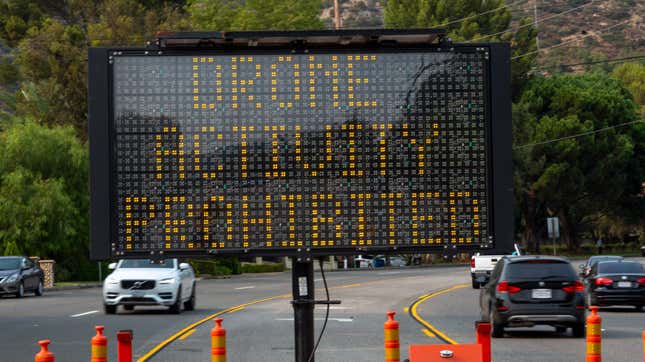
Louisiana’s looking out to protect its pipelines and chemical plants from drones, raising the specter of nefarious climate protesters to pass the legislation. But the main pilots they’ve busted so far appear to be literal children.
A bill before Gov. John Bel Edwards would seriously increase the penalties for flying drones over petrochemical facilities and pipelines, doubling the previous fine from $2,000 to $4,000 as well as increasing the maximum prison sentence from one year to two years for a second offense.
According to the Louisiana Illuminator, Jeff Hirsch, a lieutenant detective with the St. Charles Parish Sheriff’s office, told a House Administration of Criminal Justice Committee last month that his office had detected 58,000 drones and has talked to 32 drone operators who had flown illegally over certain facilities. But, Hirsh added, most of those operators weren’t antifa or some other conservative boogeyman, but rather kids playing around with their new toy.
“To date, we’ve only had one second offense, and the father sold the son’s drone,” Hirsh said during the hearing. Scary!
It may seem like overkill to pass legislation to protect chemical plants from kids with overactive drones, but some of the bill’s corporate supporters—which include the Louisiana Chemical Association, the Louisiana Mid-Continent Oil and Gas Association, and the Louisiana Association of Business and Industry—show that the move is just the latest in Louisiana’s march to protect oil, gas, and chemical infrastructure at all costs.
In 2017, activists in the state began organizing against the Bayou Bridge Pipeline, a project owned by Enbridge Energy, that transports crude oil over 160 miles (258 kilometers) of Louisiana’s swamps. Louisiana designated pipelines “critical infrastructure” the next year, making it a felony for people to trespass or otherwise demonstrate or congregate at construction sites, with a possible five-year prison sentence attached. Louisiana is one of 16 states that have passed a version of a critical infrastructure bill, many of which are nearly identical to a version drafted by the oil-and-gas-allied American Legislative Exchange Council.
Almost immediately after the Louisiana version was passed, several people, including a journalist, were arrested and charged with critical infrastructure trespass charges. There’s some promising pushback against Louisiana’s militarization. In 2019, activists filed a lawsuit against the state, charging that the critical infrastructure law is unconstitutional; last month, a judge allowed the suit to proceed, despite petitions to dismiss the suit. Louisiana is also at the forefront of the oil and gas industry’s new push to develop plastics and chemical plants, which has attracted increased attention from activists and the media in recent months. Much of that attention has focused on St. James Parish, known as Cancer Alley due to its high concentration of petrochemical plants and attendant health issues.
“Historically, Black, Indigenous, poor and working-class communities, they’re been disproportionately impacted by oil and gas and pipeline expansion,” said Ramón Mejía, an Iraq veteran and anti-militarism organizer with the Grassroots Global Justice Alliance, who is part of the critical infrastructure lawsuit following his arrest in 2018.
Drones can be useful tools for people organizing resistance around pipelines. In 2016, protesters at Standing Rock used cameras mounted drones to monitor Dakota Access pipeline construction at sacred sites and track police activity. Live drone footage streamed to social media also helped show the world how violent the cops were to protesters on the ground during the #NoDAPL demonstrations. The cops also didn’t think twice to attack drones themselves: at least one drone was shot out of the air after a police helicopter reported it approached in a “threatening manner” and passengers were “in fear of their lives” from the drone (whatever that means). At least two protesters were arrested for illegally operating drones in the airspace during the #NoDAPL demonstrations.
“Communities have reclaimed this kind of technology that’s been associated with state surveillance and the targeted killing of people overseas,” Mejía said. “Corporations and the state are working together once again to silence the attempted uncovering of illegal and unethical operations that some of these facilities participate in. This is another attempt to silence what freedom people have to be able to hold these corporations and the state accountable.”
Recent years have shown that it is the police that are overwhelmingly using drones to monitor protesters, not the other way around. Flight records show that Customs and Border Patrol conducted drone flyovers near Indigenous activists’ homes in Minnesota, where the contested Line 3 pipeline is being built. Data reported last summer shows that the Department of Homeland Security logged at least 270 hours of air-based surveillance, using helicopters, drones, and other tools in 15 states to monitor Black Lives Matter protests following the death of George Floyd.
Hirsch said that his parish has a goal “to have a net of protection that follows critical infrastructure along the Mississippi River.” To Mejía, that brings up questions about what the state is really invested in.
“The Mississippi is being polluted every single day” by companies the bill would protect, Mejía said. “How can we redefine what ‘safety’ means? Is it the safety of people being able to speak up and protect what is sacred and is vulnerable?”